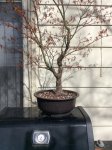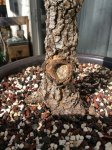Oso, huh, really? You think just let em do their thing? Since I was hoping for some horticultural reasoning for timing, what's your thoughts on why to not do it? It seems proven in my experience, but no data actually accumulated. I've read many of your posts and it seems you're actually very pensive and educated concerning horticulture, so I am psyched to hear from you.
You cast the bait and I bite

.
Just think it though about how a tree grows. There is a layer of 'stem' cells called the vascular cambium that divides to produce (radial) growth - most differentiate into xylem (inside the line of cambium cells) and some to phloem or inner bark (outside the line of cambium cells). Of course phloem ends up mixed with cork cells and eventually dies to make bark. Until then there's an epidermal covering.
Sever the line of cambium cells and it re-establishes this order - we in bonsai and arborists call this new epidermis a lip or 'callus'. This 'lip' becomes curved. The layer of cambium curves likewise, just below the surface. As this cambium does its thing, new wood is created to the inside of this curve and new phloem closer to the surface. The lip is said to 'roll' across the surface, but all the motion is happening by simply adding bricks (xylem and phloem) to the edge of the wall. It does not roll. It does not slide or push across.
So Lindsay Far says the lip gets caught up or somesuch and that one needs to (as you said) 're-injure the scar'. This 're-injury' amounts to cutting off some of the epidermis, cambium and xylem behind it. Seems perfectly obvious that this is just taking a step backwards. You've removed recently formed tissue and now have to go through that whole process of forming callus and then grow again that tissue you just removed before any progress is to again be made. That is, unless this damage leads to some kind of enhanced growth. In my thread "
regarding-wound-healing" I did this in a systematic way and this is indeed how things behaved and there was no enhanced growth.
Digressing, wood or more precisely, cellulose, is just a sugar polymer. Sugars are the product of photosynthesis which are carried down the tree from the foliage toward the roots in the phloem. So, IMHO, the real secret of wound 'healing' is somehow steering the flow of sugars to the callus/lip. Just 're-injuring' won't change the flow in a productive way. Of that much, I am certain (which really isn't much, really). Getting a bud pop from the branch collar of your lopped off branch is a big help - a supply of sugars right where you need it. Barring that, grafting can add a supply of sugars to the tissues below the graft point (presumably where its needed). Arborists have shown that carving inverted tear drop shapes on trunks at branch pruning wounds helps - I don't understand why works, but really would like to so that I could apply that to my problems.
Since I am running on, there are a pair (or a group) of special cambium cells at the tip of every shoot (as well as the tip of every root) called the 'apical meristem'. The division of these cells produce shoot/root elongation and have a complex do-loop of auxin activity that periodically produces an auxin pulse. This pulse results in another special group of vascular cambium cells that can become apical meristems (buds) when given the right conditions sometime in the future - latent buds. This growth event marks a node. When the apical meristem is removed (aka shoot decapitation), the distal buds are released = why we prune branches a roots to ramify them. Anyway, the key point for your inquiry is that the cellular structures to produce bud are only made by apical meristems. Hence 'scar tissue' of the sort you are asking, will be barren/bud-less for ever and ever because there is no apical meristem involved in the process (just lateral/vascular/secondary cambium).
How's that for pedantry?

This is how one makes Geek foie gras

BTW, how is dear ol' CU and Boulder?




